

2014 January 6 - Three CubeSats Released. 2013 December 29 - Time Lapse Auroras Over Norway. 2013 December 27 - Melotte 15 in the Heart. Discover the cosmos!

Each day a different image or photograph of our fascinating universe is featured, along with a brief explanation written by a professional astronomer. 2013 December 27 Melotte 15 in the Heart Image Credit & Copyright: Jimmy Walker Explanation: Cosmic clouds seem to form fantastic shapes in the central regions of emission nebula IC 1805. Of course, the clouds are sculpted by stellar winds and radiation from massive hot stars in the nebula's newborn star cluster, Melotte 15. Tomorrow's picture: light-weekend Authors & editors: Robert Nemiroff (MTU) & Jerry Bonnell (UMCP)NASA Official: Phillip Newman Specific rights apply.NASA Web Privacy Policy and Important NoticesA service of:ASD at NASA / GSFC& Michigan Tech.
Painted Lines on an Ornament. 2013 December 25 - Phobos 360. Astronomy Picture of the Day: 12/24/13 – The Christmas Ornament Nebula. Credit: NASA, ESA, and G.
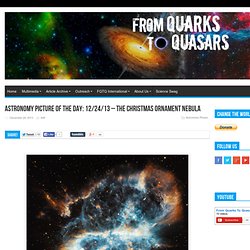
Bacon (STScI) Happy Holidays from those of us here on the FQTQ team. To get in the festive spirit, we thought we would showcase one of the ‘christmassy’ nebulae out there. This particular one, curiously dubbed the “Christmas Ornament nebula” (also known as NGC 5189), is a planetary nebula that can be found approximately 1,780 light-years from Earth in the constellation of Musca. The planetary nebula stage of stellar evolution is one of the last few transitions a sun-like star experiences as the star begins to die.
Do you guys have any favorite deep space images that remind you of Christmas? Jaime Trosper Jaime is a freelance writer, who feels like she can't be summarized in a single paragraph. 2013 December 24 - Sharpless 308: Star Bubble. Discover the cosmos!
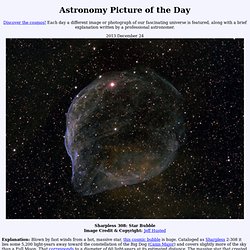
Each day a different image or photograph of our fascinating universe is featured, along with a brief explanation written by a professional astronomer. 2013 December 24 Explanation: Blown by fast winds from a hot, massive star, this cosmic bubble is huge. Cataloged as Sharpless 2-308 it lies some 5,200 light-years away toward the constellation of the Big Dog (Canis Major) and covers slightly more of the sky than a Full Moon. That corresponds to a diameter of 60 light-years at its estimated distance. 2002 February 13 - The Great Nebula in Orion. Tutulemma_tezel_960.jpg (960×731) Astronomy Picture of the Day.
2013 December 19 - A Colorful Moon. Discover the cosmos!
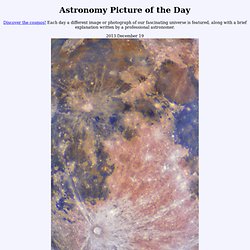
Each day a different image or photograph of our fascinating universe is featured, along with a brief explanation written by a professional astronomer. 2013 December 19 Explanation: The Moon is normally seen in subtle shades of grey or yellow. But small, measurable color differences have been greatly exaggerated to make this telescopic, multicolored, moonscape captured during the Moon's full phase. Astronomers May Have Found the First-Ever Exomoon.
Astronomers at University of Notre Dame, Indiana claim they have seen the human race’s first-ever exomoon, and it seems weirder than we ever could have imagined.
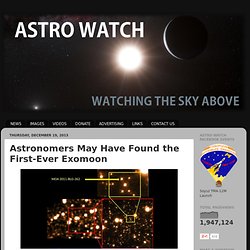
MOA-2011-BLG-262 is the shortest duration microlensing event to date with a planetary mass companion, and the lens-source relative proper motion is unusually high. The high relative proper motion suggests a nearby lens, but if this is the case, then the primary must have a mass of a few Jupiter masses. This would imply that the secondary is an exomoon of about an Earth mass. The other alternative is that the velocity of the planet host star is quite large, implying that it resides in the Milky Way's halo. Exomoons have long been predicted to exist – some may even be habitable worlds – but until now, no one had detected any. Most of the 1000 or so exoplanets discovered to date were found by analysing changes in the light of their star, but a select few have been seen using a technique called gravitational microlensing. 2013 December 17 - Geminid Meteors over Teide Volcano. Discover the cosmos! 2013 December 15 - Gibbous Europa. Discover the cosmos!

Each day a different image or photograph of our fascinating universe is featured, along with a brief explanation written by a professional astronomer. 2013 December 15 Gibbous Europa Image Credit: Galileo Project, JPL, NASA; Copyright: reprocessed by Ted Stryk Explanation: Although the phase of this moon might appear familiar, the moon itself might not. In fact, this gibbous phase shows part of Jupiter's moon Europa. Budget Universe: Free APOD 2014 Calendar in PDF format Tomorrow's picture: jade rabbit Authors & editors: Robert Nemiroff (MTU) & Jerry Bonnell (UMCP)NASA Official: Phillip Newman Specific rights apply.NASA Web Privacy Policy and Important NoticesA service of:ASD at NASA / GSFC& Michigan Tech. Astronomy Picture of the Day. PIA14934_saturn.jpg (6672×3104) Mb_2013-11-30_OrionsBelt.jpg (2048×2114) 2008 December 10 - Portrait of NGC 281. Discover the cosmos!
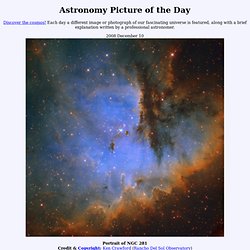
Each day a different image or photograph of our fascinating universe is featured, along with a brief explanation written by a professional astronomer. 2008 December 10 Portrait of NGC 281 Credit & Copyright: Ken Crawford (Rancho Del Sol Observatory) Explanation: Look through the cosmic cloud cataloged as NGC 281 and it's almost easy to miss stars of open cluster IC 1590. But, formed within the nebula, that cluster's young, massive stars ultimately power the pervasive nebular glow. Astronomy Picture of the Day. Astronomy Picture of the Day. 2013 November 19 - Globular Cluster M15 from Hubble.
2013 December 2 - Comet Lovejoy Before Galaxy M63. Discover the cosmos!

Each day a different image or photograph of our fascinating universe is featured, along with a brief explanation written by a professional astronomer. 2013 December 2 Explanation: Comet Lovejoy was captured last week passing well in front of spiral galaxy M63. Discovered only three months ago and currently near its maximum brightness, Comet Lovejoy can be seen near the Big Dipper from dark northerly locations before dawn with the unaided eye. An unexpected rival to Comet ISON, C/2013 R1 (Lovejoy), pictured above, is currently sporting a large green coma and a beautifully textured ion tail. Astronomy Picture of the Day. 2012 November 21 - Diamond Ring and Shadow Bands. Discover the cosmos!

Each day a different image or photograph of our fascinating universe is featured, along with a brief explanation written by a professional astronomer. 2012 November 21 Explanation: As the total phase of last week's solar eclipse came to an end, sunlight streaming past the edge of the Moon created the fleeting appearance of a glistening diamond ring in the sky. And while most eclipse watchers did not consider clouds a welcome sight, a view through thin clouds north of Cairns in Queensland, Australia also revealed these remarkable flickering shadow bands.